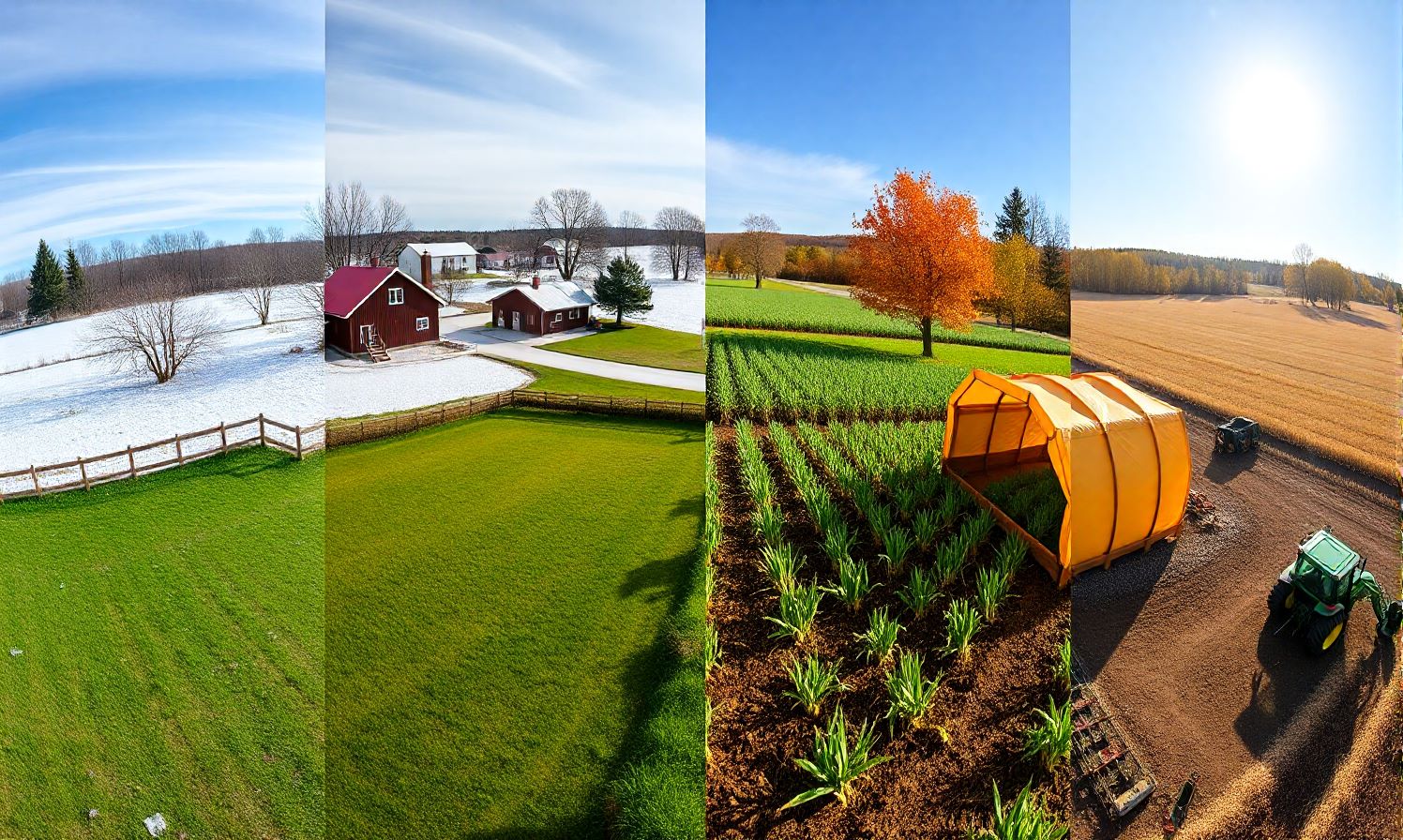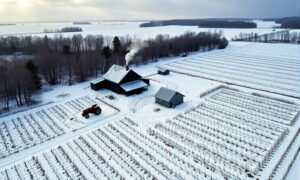
Living on 5 acres year-round can be an incredibly rewarding experience, but it requires thoughtful planning and adaptability. Each season brings its own set of challenges and opportunities, whether it’s managing the harsh winters, taking advantage of the spring growth, or making the most of the long summer days. By understanding how to adjust your lifestyle and property management practices to fit the changing seasons, you can ensure your 5-acre property thrives all year long.
How to Prepare Your 5-Acre Homestead for Winter
Winter on a 5-acre property often demands more preparation than any other season. Without a doubt, ensuring that your home, livestock, and land are ready for the cold months ahead is crucial for a successful and comfortable winter.
Winterizing Your Home on a 5-Acre Property
The first step in adapting to winter is winterizing your home. Proper insulation is key. By adding insulation to your attic, walls, and floors, you can significantly reduce heat loss, keeping your home warmer and your energy bills lower. Moreover, sealing any drafts around windows and doors is essential to prevent cold air from sneaking in.
In addition to insulation, consider installing storm windows if your area experiences severe winter weather. These windows provide an extra layer of protection against the cold, reducing the strain on your heating system.
Routine maintenance is also critical. Before winter arrives, clean out your gutters to prevent ice dams, which can cause significant damage to your roof. Additionally, servicing your heating system will ensure it runs efficiently throughout the season.
Protecting Livestock and Crops During Winter
Living on 5 acres year-round often means taking care of livestock and crops, even when the weather turns icy. Protecting your animals from the cold involves providing adequate shelter. A well-insulated barn or stable will keep your livestock safe from freezing temperatures. If you don’t have a permanent structure, temporary shelters like hoop houses can also be effective.
Ensuring a reliable water source is another vital aspect of winter care. Water can freeze quickly in cold weather, so using heated waterers or insulating water troughs can prevent this issue and ensure your animals stay hydrated.
For crops, winter preparation involves more than just covering them with frost blankets. Mulching heavily around the base of plants can insulate the soil and roots, helping them survive the cold months. Additionally, planting cover crops in the fall can protect the soil from erosion and add nutrients for the next growing season.
Snow and Ice Management on 5 Acres
Managing snow and ice on a 5-acre property can be a significant task, but with the right approach, it becomes manageable. First and foremost, having the proper tools is essential. A sturdy snow shovel or a snow blower can make clearing driveways and pathways much easier. For larger areas, a tractor with a snowplow attachment might be necessary.
In areas prone to ice, spreading sand or salt on walkways and driveways can help prevent slips and falls. However, it’s important to use these materials sparingly to avoid damage to your landscaping and local waterways.
Additionally, consider investing in a backup generator. Power outages are common during winter storms, and a generator can keep your home and livestock facilities running smoothly, preventing any disruptions to your daily routine.
Revitalize Your 5 Acres: Essential Spring Tasks
As the snow melts and the temperatures rise, spring brings new life to your 5-acre property. It’s a time for cleaning, planting, and preparing your land for the productive months ahead. Adapting to the spring season is key to ensuring your property remains healthy and vibrant.
Spring Cleaning and Maintenance for Your 5-Acre Property
Spring is the perfect time to refresh your property after the long winter months. Begin by conducting a thorough inspection of your home and outbuildings. Look for any damage that may have occurred over the winter, such as cracked foundations, loose shingles, or damaged fences. Addressing these issues early will prevent them from worsening as the year progresses.
Cleaning up debris is another essential task. Winter storms often leave behind fallen branches, leaves, and other debris that can clutter your property. Clearing this debris not only improves the appearance of your land but also reduces the risk of pests and disease.
Another key spring task is servicing your equipment. Before the busy summer season begins, make sure your lawnmowers, tractors, and other machinery are in good working order. Regular maintenance, such as oil changes and blade sharpening, will extend the life of your equipment and ensure it’s ready when you need it.
Planting and Gardening on 5 Acres in Spring
Spring is the most exciting time for gardeners living on 5 acres year-round. The longer days and warming soil provide ideal conditions for planting a wide variety of crops. Whether you’re growing vegetables, flowers, or fruit trees, timing is crucial.
Start by preparing your garden beds. Turn the soil and add compost to replenish nutrients depleted over the winter. If you’re planting in raised beds, ensure they are filled with fresh, nutrient-rich soil to support healthy plant growth.
When choosing crops, consider both the climate and your specific needs. Cool-season vegetables like lettuce, peas, and radishes can be planted early in the spring, while warm-season crops like tomatoes and peppers should be started indoors and transplanted after the last frost.
For those interested in expanding their garden, spring is also the perfect time to plant fruit trees and berry bushes. These perennials require a few years to mature, so planting them now ensures they will be productive in the future.
Encouraging Wildlife and Pollinators on Your 5-Acre Property
Living on 5 acres year-round offers a unique opportunity to create a haven for wildlife and pollinators. Spring is an excellent time to implement practices that encourage these beneficial creatures to visit and thrive on your property.
Start by planting native flowers and shrubs that provide food and habitat for local wildlife. Pollinators like bees and butterflies are particularly attracted to flowers such as milkweed, coneflower, and lavender. Additionally, consider planting a variety of species that bloom at different times throughout the season to provide a continuous food source.
Providing water sources is also important. A small pond or birdbath can attract a variety of wildlife, from birds to amphibians. Make sure to keep the water clean and fresh, especially during dry spells.
Moreover, reducing the use of pesticides and herbicides on your property will help create a safer environment for pollinators and other wildlife. Organic gardening practices not only protect the ecosystem but also improve the health of your soil and plants.
Maximizing Summer on Your 5 Acres: Tips and Tricks
Summer on a 5-acre property can be both productive and enjoyable. The long days and warm weather offer plenty of opportunities for outdoor activities and property maintenance. However, adapting to the heat and increased workload is essential for thriving throughout the summer months.
Managing Heat and Water Needs on a 5-Acre Property
When living on 5 acres year-round, managing the heat during summer becomes a top priority. Ensuring your home stays cool is crucial, and there are several ways to achieve this without relying solely on air conditioning. One of the most effective methods is to use fans and natural ventilation. By opening windows during the cooler parts of the day and closing them when it heats up, you can reduce indoor temperatures significantly.
For your outdoor spaces, shade is key. Planting trees around your home and outdoor living areas can provide much-needed relief from the sun. Additionally, using shade cloths or pergolas over garden beds can protect plants from scorching and reduce water evaporation.
Water management is another critical aspect of summer living on 5 acres year-round. With the hot weather comes the need for increased irrigation, but water conservation is equally important. Drip irrigation systems are highly efficient, delivering water directly to the plant roots, reducing waste. Additionally, collecting rainwater in barrels during the wetter months and using it during dry spells can help reduce your reliance on municipal water supplies.
Summer Fun and Activities for 5-Acre Properties
Summer is also a time to enjoy the outdoors, and living on 5 acres year-round offers endless possibilities for recreation. Whether you’re entertaining guests or spending quality time with family, there’s no shortage of activities to keep everyone engaged.
One popular summer activity is setting up a backyard oasis. With a bit of planning, you can create a relaxing outdoor space complete with comfortable seating, a fire pit, and perhaps even a small pool or hot tub. These features not only enhance your enjoyment of the property but also add value to your home.
For families, summer is the perfect time to explore nature. Hiking trails, wildlife watching, and picnicking are all great ways to enjoy the natural beauty of your 5-acre property. Additionally, consider setting up a camping area where you can spend nights under the stars without leaving your land.
If you’re interested in gardening, summer is the season for harvesting many crops. Involve your family in picking fruits and vegetables, which can then be used for fresh, home-cooked meals. Not only does this provide a sense of accomplishment, but it also teaches valuable life skills.
Summer Maintenance Tasks for Living on 5 Acres Year-Round
While summer is a time for fun, it’s also a season that requires diligent maintenance to keep your 5-acre property in top shape. Routine tasks will help prevent small issues from becoming major problems and ensure your land remains productive.
Lawn care is a key summer maintenance task. Mowing regularly, but not too short, helps keep your grass healthy and prevents weeds from taking over. In addition, watering your lawn deeply and infrequently encourages deep root growth, making your grass more resilient to drought.
Another important task is pest control. Summer is when many pests, such as insects and rodents, are most active. Regularly inspect your home, garden, and livestock areas for signs of infestation. Using traps, barriers, and natural repellents can help manage pest populations without resorting to harmful chemicals.
Finally, summer is an excellent time to make any necessary repairs to your property’s infrastructure. Whether it’s fixing a broken fence, repairing an outbuilding, or touching up paint on your home, taking care of these tasks now will save you time and money down the road.
Preparing for Fall: Essential Tasks for Your 5-Acre Homestead
As the summer heat fades and the leaves begin to change, fall is a time of transition. Preparing your 5-acre property for the colder months ahead is essential for a smooth transition into winter. By focusing on harvesting, maintenance, and wildlife management, you can ensure your property remains in peak condition year-round.
Harvesting Crops on Your 5-Acre Homestead
Fall is the culmination of your summer gardening efforts, and harvesting is a rewarding task when living on 5 acres year-round. However, it requires careful planning to ensure you make the most of your crops before winter arrives.
Begin by harvesting perishable crops first, such as tomatoes, peppers, and berries. These fruits and vegetables can be eaten fresh, preserved, or canned to enjoy throughout the winter. Root vegetables like carrots, beets, and potatoes can be left in the ground a bit longer, as they are more tolerant of cooler temperatures.
For those with fruit trees, fall is also the time to pick apples, pears, and other late-season fruits. Be sure to handle fruit gently to avoid bruising, and store them in a cool, dark place to extend their shelf life.
If you’ve grown pumpkins or squash, these should be harvested before the first frost. Allow them to cure in the sun for a week or two, which hardens their skin and helps them last longer in storage.
Fall Maintenance Checklist for 5-Acre Properties
Fall maintenance is crucial for preparing your property for the winter months. Creating a comprehensive checklist ensures that no important tasks are overlooked.
Start by cleaning up your garden beds. Remove any dead plants, as they can harbor pests and diseases over the winter. Add compost or mulch to the beds to protect the soil and improve its fertility for next spring.
Next, focus on your home and outbuildings. Inspect your roof and gutters for any damage, and make repairs as needed. Cleaning out gutters is particularly important in the fall to prevent ice dams during winter. Additionally, check windows and doors for drafts and seal them to keep the cold air out.
If you have a fireplace or wood stove, now is the time to have it cleaned and inspected. This ensures it will operate safely and efficiently throughout the winter. Don’t forget to stock up on firewood if you rely on it for heating.
Finally, make sure all your equipment is ready for winter storage. Drain the fuel from lawnmowers and other gas-powered tools, and store them in a dry, sheltered area. Covering larger equipment like tractors will protect them from the elements.
Wildlife and Pest Management in Fall
As the weather cools, wildlife begins to prepare for winter, and pests may start seeking shelter on your property. Managing these animals is an important part of adapting to the fall season when living on 5 acres year-round.
To support wildlife, consider leaving some areas of your property undisturbed. Piles of leaves, brush, and fallen logs provide habitat for small mammals, insects, and birds. Installing bird feeders and nesting boxes can also help local wildlife survive the winter.
At the same time, it’s important to keep pests out of your home and outbuildings. Seal any cracks or holes where rodents could enter, and store food in airtight containers to deter them. Setting traps in areas where pests are likely to enter can help control their population before they become a problem.
Additionally, consider implementing a fall pest control routine in your garden. Removing crop residues and applying natural repellents can reduce the number of pests that overwinter in your soil, leading to fewer problems in the spring.
Dealing with Seasonal Weather Challenges on a 5-Acre Property Year-Round
One of the most significant aspects of living on 5 acres year-round is dealing with the varied weather challenges each season brings. Whether it’s managing floods in the spring, wildfires in the summer, or windstorms in the fall, being prepared for these events is crucial for protecting your property.
Flood Management on a 5-Acre Property
Flooding can be a significant concern, particularly in the spring when snowmelt and heavy rains are common. To manage flood risks on your 5-acre property, it’s important to have a well-planned drainage system in place.
Start by assessing the natural water flow on your property. Identify areas where water tends to accumulate and consider installing French drains, swales, or retention ponds to redirect water away from vulnerable areas. Keeping ditches and culverts clear of debris is also essential for preventing backups that can lead to flooding.
If your home is in a flood-prone area, consider adding sandbags or other barriers around your foundation to keep water out. Elevating electrical outlets, appliances, and HVAC systems above potential flood levels can also reduce the risk of damage.
Wildfire Prevention and Safety on 5 Acres
For those living in areas prone to wildfires, taking steps to fireproof your property is vital. Start by creating a defensible space around your home. This involves clearing away flammable vegetation within 30 feet of your house and trimming trees so that their branches are at least 10 feet from your roof.
Installing fire-resistant materials on your home, such as metal roofing and siding, can also reduce the risk of fire damage. Additionally, keeping gutters clean and free of dry leaves and pine needles is crucial, as these can easily ignite if embers land on your roof.
Having an emergency plan in place is another important aspect of wildfire preparedness. Make sure you know the evacuation routes from your property, and have a “go bag” packed with essential items in case you need to leave quickly. Staying informed about local fire conditions through apps or alerts can give you the time you need to protect your home and family.
Windproofing Your 5-Acre Property for Year-Round Living
High winds can cause significant damage to structures and vegetation, especially in rural areas. Windproofing your property is an important part of living on 5 acres year-round.
Start by securing any loose items around your property, such as patio furniture, tools, and garden decorations. These can become dangerous projectiles in strong winds. For larger structures like barns or sheds, ensure they are anchored securely to the ground.
Planting windbreaks is another effective way to protect your property from high winds. Rows of trees or shrubs planted along the windward side of your property can reduce wind speed and prevent soil erosion. When selecting plants for a windbreak, choose hardy, deep-rooted species that can withstand strong winds.
Inspecting and reinforcing your home’s roof is also crucial. High winds can lift shingles or even entire sections of the roof if they are not properly secured. Adding hurricane straps or clips can help hold the roof down during a storm.
Conclusion
Living on 5 acres year-round offers a unique and fulfilling lifestyle, but it also comes with its share of challenges. By adapting to the changing seasons and taking proactive steps to manage your property, you can ensure that your 5-acre homestead remains productive, safe, and enjoyable throughout the year. Whether it’s preparing for winter’s chill, making the most of summer’s warmth, or protecting your land from seasonal weather events, being prepared and adaptable is key to thriving on your rural property.
If you found these tips helpful, explore our other articles on seasonal maintenance and rural living. Don’t forget to sign up for our newsletter to receive regular updates and tips on managing your 5-acre property year-round!
FAQs
- What is the best way to prepare for winter on a 5-acre property?
- Focus on insulating your home, protecting your livestock, and having the right tools for snow and ice management.
- How can I conserve water during the summer on my 5-acre property?
- Use drip irrigation, collect rainwater, and plant drought-tolerant plants to reduce water usage.
- What should I plant in spring on a 5-acre homestead?
- Consider cool-season vegetables, fruit trees, and pollinator-friendly flowers to kickstart your spring garden.
- How do I prevent wildfires from damaging my property?
- Create a defensible space, use fire-resistant materials on your home, and have an emergency plan in place.
- What is a windbreak, and how can it help my property?
- A windbreak is a row of trees or shrubs that reduces wind speed, protecting your home and land from damage.
- How do I handle pests in the fall?
- Seal entry points, store food securely, and implement natural pest control methods to keep pests at bay.
- What tools are essential for living on 5 acres year-round?
- A snow blower, a tractor with attachments, and a backup generator are all important tools for maintaining a 5-acre property.
- How can I make the most of my summer on a 5-acre property?
- Create an outdoor living space, enjoy outdoor activities, and harvest your crops for fresh meals.
- What maintenance should I prioritize in the fall?
- Focus on garden cleanup, roof and gutter inspections, and preparing equipment for winter storage.
- Why is seasonal adaptation important for living on 5 acres year-round?
- Seasonal adaptation helps you maintain your property’s health and productivity, ensuring it remains a safe and enjoyable place to live.




